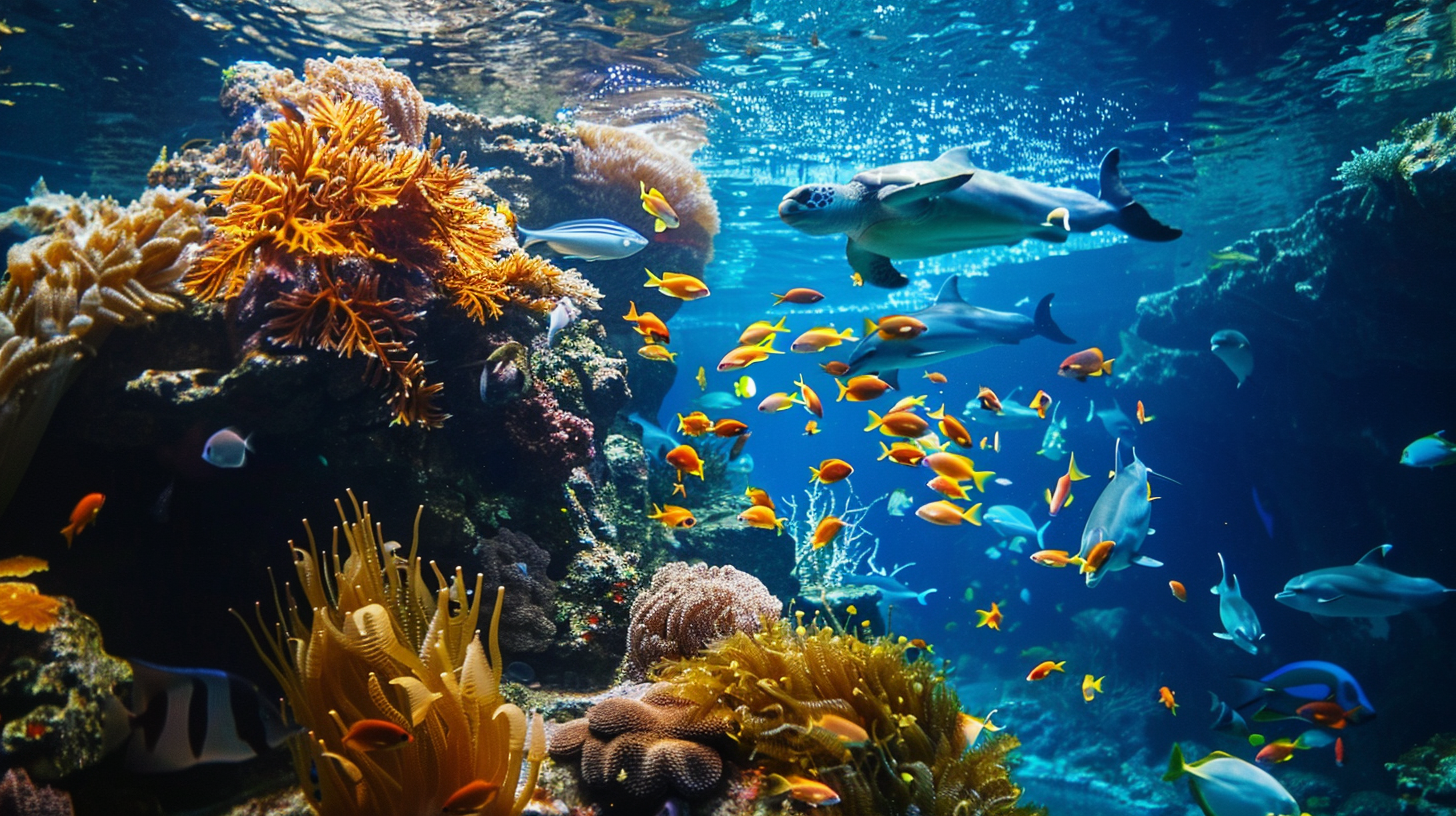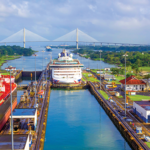Explore the depths of the marine biome with a journey through essential facts that reveal the mysteries of the ocean. From the intricate interplay of species to the unforeseen challenges faced by marine ecosystems, a nuanced understanding of these ten key insights will reshape your perspective on the underwater world. Prepare to uncover the hidden wonders and pressing issues that shape the future of our oceans.
Importance of the Marine Biome

The Marine Biome plays an important role in sustaining life on Earth, covering approximately 71% of the planet’s surface. Within this vast biome, nutrient cycling is a significant process that supports various marine ecosystems.
Oceanic currents, driven by factors such as wind, the Earth’s rotation, and temperature gradients, play a considerable role in distributing nutrients throughout the marine environment. These currents transport necessary nutrients such as nitrogen, phosphorus, and iron to different regions, promoting the growth of marine plants like phytoplankton, which form the base of the marine food chain.
Nutrient cycling in the Marine Biome is a complex web of processes involving the uptake, utilization, and recycling of necessary elements by marine organisms. Phytoplankton, for example, absorb nutrients from the water, which are then passed on to zooplankton and other marine organisms as they feed on each other.
This cycling of nutrients is fundamental for the overall health and productivity of marine ecosystems, supporting a diverse array of marine life forms from microscopic plankton to large marine mammals.
Biodiversity Hotspots Underwater
Biodiversity hotspots underwater represent areas of exceptional marine richness and diversity. These underwater ecosystems are essential for maintaining oceanic biodiversity.
From coral reefs teeming with life to deep-sea habitats supporting unique species, these hotspots play an important role in the health of our oceans. The Great Barrier Reef in Australia, for example, is one of the most famous biodiversity hotspots underwater, home to a vast array of marine life.
Similarly, the waters surrounding the Galapagos Islands boast incredible biodiversity, with numerous endemic species found nowhere else on Earth. These hotspots serve as breeding grounds, feeding areas, and shelters for a multitude of marine organisms, contributing to the overall balance of the marine biome.
Understanding and protecting these underwater biodiversity hotspots is critical for preserving the delicate equilibrium of our oceans and ensuring the survival of countless species that rely on them.
Threats Facing Marine Ecosystems
Amidst the vast expanse of the world’s oceans, marine ecosystems face a myriad of threats that endanger the delicate balance of life below the surface.
These threats include:
- Overfishing: The unsustainable harvesting of marine species disrupts food chains and can lead to the depletion of vital populations, affecting the overall health of the ecosystem.
- Plastic Pollution: The accumulation of plastic waste in the oceans poses a severe threat to marine life, causing entanglement, ingestion, and habitat destruction.
- Lack of Effective Regulations: Inadequate regulations and enforcement mechanisms contribute to the overexploitation of marine resources, hindering the ecosystem’s ability to recover and thrive.
To address these threats, it’s essential to implement stringent overfishing regulations to guarantee the sustainable use of marine resources.
Additionally, efforts to reduce plastic pollution through proper waste management and awareness campaigns are critical in safeguarding the health of marine ecosystems for future generations.
Coral Reefs and Their Significance
Coral reefs, known as the “rainforests of the sea,” are intricate underwater ecosystems teeming with life and vibrant colors. These reefs are home to a quarter of all marine species, despite covering less than 1% of the ocean floor.
One of the most fascinating aspects of coral reefs is the coral symbiosis, a mutually beneficial relationship between coral polyps and algae. The algae provide energy through photosynthesis, while the coral provides shelter and nutrients. This relationship is essential for the survival and growth of coral reefs.
Moreover, coral reefs play a significant role in maintaining the health of the oceans. They act as natural barriers, protecting coastlines from erosion and buffering the impacts of storms. Additionally, coral reefs contribute to reef resilience, the ability of reefs to withstand and recover from environmental stresses.
Unfortunately, coral reefs are facing significant threats such as climate change, overfishing, and pollution. It’s imperative to protect these valuable ecosystems to guarantee their survival and the preservation of marine biodiversity.
Adaptations of Marine Species
In the vast and dynamic marine biome, the adaptations of marine species are a demonstration of the incredible diversity and resilience of life beneath the waves.
Marine species have evolved various strategies to thrive in their environment:
- Mimicry Strategies: Some species mimic the appearance of other organisms to deter predators or deceive prey.
- Buoyancy Adaptations: Marine species have developed specialized structures or behaviors to control their buoyancy, allowing them to move efficiently in the water column.
- Camouflage Techniques: Many marine species use camouflage to blend into their surroundings, providing them with a significant advantage in avoiding detection by predators or enhancing their hunting success.
These adaptations are essential for marine species to survive in their habitats, influencing their feeding behaviors, reproductive strategies, sensory adaptations, locomotion methods, predator-prey interactions, and overall survival tactics.
The intricate balance of these adaptations contributes to the rich tapestry of life in the marine biome.
Impact of Climate Change
As climate change continues to alter global environmental conditions, the marine biome is experiencing a range of significant impacts that are reshaping ecosystems and challenging the survival of marine species.
One of the key consequences of climate change on the marine biome is ocean acidification. The increasing levels of carbon dioxide in the atmosphere are being absorbed by the oceans, leading to a decrease in pH levels. This acidification poses a threat to marine life, especially organisms with calcium carbonate shells, as it makes it harder for them to build and maintain their shells.
Additionally, sea level rise, another consequence of climate change, is affecting coastal habitats and species. Rising sea levels lead to coastal erosion, loss of habitat, and increased flooding events. This poses a direct threat to species that rely on coastal areas for breeding, feeding, and shelter.
The combination of ocean acidification and sea level rise presents a significant challenge to the delicate balance of marine ecosystems and the survival of many marine species.
Deep-Sea Mysteries Revealed
Revealing the mysteries of the deep sea has long captivated scientists and researchers, offering a glimpse into an otherworldly domain teeming with unique life forms and ecosystems.
Deep sea exploration has disclosed astonishing secrets, shedding light on the enigmatic world beneath the waves.
- Bioluminescent Organisms: The deep sea is home to an array of bioluminescent organisms that produce light through chemical reactions. These creatures create a mesmerizing light show in the dark depths, serving various functions from attracting prey to communication.
- Extreme Adaptations: Life in the deep sea has led to remarkable adaptations, such as creatures with elongated jaws and expandable stomachs to consume prey larger than themselves. These adaptations showcase the ingenuity of evolution in the face of extreme conditions.
- Mysterious Ecosystems: Deep-sea ecosystems are interconnected in intricate ways, with species relying on each other for survival in the challenging environment of the abyssal plains.
Understanding these ecosystems is essential for conservation efforts and biodiversity preservation.
Human Activities and the Ocean
Exploring the impact of human activities on the ocean reveals a complex interplay between industrial practices and marine ecosystems.
Ocean pollution, stemming from activities like oil spills and plastic dumping, poses a severe threat to marine life. The introduction of harmful chemicals and debris disrupts the delicate balance of the ocean’s ecosystems, leading to devastating consequences for marine species.
On the other hand, sustainable fishing practices are essential for maintaining the health of ocean ecosystems. Overfishing can deplete fish populations and disrupt food chains, causing cascading effects throughout the marine biome.
Marine Biome Conservation Efforts
Investigating Marine Biome Conservation Efforts requires an extensive understanding of the various strategies aimed at protecting and preserving the delicate ecosystems of the world’s oceans.
Conservation efforts in the marine biome focus on implementing measures to guarantee the sustainability of marine resources and the overall health of the ocean environments.
Key strategies include:
- Establishment of Marine Protected Areas: Creating marine protected areas helps safeguard critical habitats and species, allowing them to thrive without the threat of human interference.
- Promotion of Sustainable Fishing Practices: Encouraging sustainable fishing practices such as limiting catch quotas, implementing gear restrictions, and enforcing seasonal closures helps prevent overfishing and guarantees the long-term viability of fish populations.
- Collaborative Conservation Initiatives: Collaborative efforts involving governments, organizations, and local communities play a crucial role in promoting marine conservation by sharing knowledge, resources, and expertise to address conservation challenges effectively.
Future Outlook for Marine Environments
In considering the future outlook for marine environments, it becomes vital to project the trajectory of conservation efforts onto the evolving landscape of the world’s oceans. Oceanic trends indicate a pressing need for innovative solutions to address challenges such as climate change, overfishing, plastic pollution, and habitat destruction.
The future of marine environments hinges on the collaboration between scientists, policymakers, industries, and the public to implement sustainable practices and policies.
To safeguard marine ecosystems, future innovations must focus on developing advanced technologies for monitoring and managing marine resources. These innovations could include the use of artificial intelligence for predictive modeling of marine biodiversity, the implementation of eco-friendly fishing practices, and the creation of marine protected areas to preserve essential habitats.
Additionally, fostering public awareness and engagement is vital for promoting ocean conservation and driving positive change.
As we navigate the complex web of oceanic trends and environmental challenges, proactive measures and forward-thinking strategies will be essential to guarantee the health and resilience of marine environments for generations to come.
Frequently Asked Questions
How Do Marine Animals Communicate With Each Other?
To communicate, marine animals use various methods. They convey messages through vocalizations, behaviors, and chemical signals. Vocalizations, such as whale songs, play an essential role. Behaviors like body postures and movements also aid in communication, along with chemical signals.
What Are the Most Extreme Deep-Sea Creatures?
Exploring the depths of the ocean reveals fascinating creatures. Bioluminescent organisms like anglerfish use light to lure prey. Deep sea adaptations include pressure-resistant bodies and unique senses. The extreme deep-sea creatures showcase the marvels of marine life.
Do Marine Plants Have Unique Adaptations?
Yes, marine plants possess unique adaptations like photosynthetic mechanisms that optimize light absorption underwater. They have developed specialized structures to withstand high salt concentrations, aiding in their survival and growth in the challenging marine environment.
Can Marine Species Migrate to Different Oceans?
Yes, marine species can migrate to different oceans through ocean currents. Their migratory patterns are influenced by environmental cues and reproductive needs. This movement aids in genetic diversity and species distribution, essential for the health of marine ecosystems.
How Do Marine Species Deal With Pollution?
Marine species cope with pollution effects through species resilience. They adapt to habitat degradation and chemical exposure by exhibiting behavioral changes. These adjustments are essential for maintaining ecosystem health in the face of environmental challenges.







